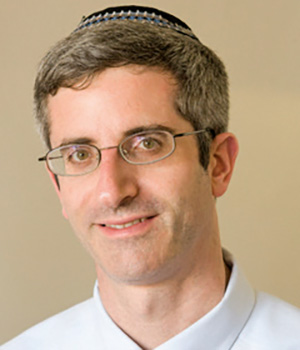
It was a full house in the Young Israel of Fort Lee on Wednesday evening, June 12, when Rabbi Hayyim Angel gave the first of his three-part shiur series, “The Interface of Traditional and Academic Bible Study,” “Peshat, Derash and the Ancient Near East: The Tower of Babel.”
Rabbi Zev Goldberg of the Young Israel of Fort Lee introduced Rabbi Angel, recalling fond memories of having taken most of his Tanach classes at YU with Rabbi Angel. Rabbi Goldberg said, “There are many events that take place over here in Fort Lee, but looking back, we are very proud of the relationship we have built with Yeshiva University.” He also thanked Jed Katz, who sponsored the lecture series.
Rabbi Angel earned his M.A. in Bible from the Bernard Revel Graduate School, his M.S. in Jewish education from the Azrieli Graduate School of Jewish Education and his rabbinical ordination from the Rabbi Isaac Elchanan Theological Seminary. He is currently the national scholar of the Institute for Jewish Ideas and Ideals. Rabbi Angel has been teaching Tanach at Yeshiva University since 1996. He has authored or edited many books and over 130 scholarly articles.
Rabbi Angel’s shiur was engaging, interactive and sprinkled with humor. He described three stages in the study of the history of the Ancient Near East and the Bible. The first scholars who explored Ancient Near Eastern culture wanted to prove the truth of the Bible, and so strove to explain every artifact as supporting it. In the second stage, scholars ignored the Bible (thereby disregarding an important source of information) and focused only on the artifacts, and the third stage is the creation of a positive dialogue between scholars of Ancient Near Eastern culture and scholars of Torah. “Not everybody in the academic world is up to round three yet, [but] that is where I think everyone should be.” The goal is not to use archaeological findings to prove or disprove the Torah, but as a tool of understanding the Torah.
Rabbi Angel then turned to the story of the Tower of Babel specifically. In Genesis 11:1-9 it describes a group of people who were of the “same language and same words,” who gathered together and wanted to build a tall tower out of bricks that reached the heavens, in order to make a name for themselves and so that they would not be scattered. God went down and confused their languages and scattered them all over the earth. The place was called Babel, “because they were confounded” (a play on the word “balal,” confused). Rabbi Angel’s central question was: What exactly did the tower builders do wrong that so concerned God? Rabbi Angel first quoted the Gemara in Sanhedrin 109a, which says the reason God came down and punished them was that the tower was built for idol worship. This explanation of why God was angry doesn’t seem to appear in the peshat, so many commentaries give alternative explanations. Some alternatives included: The Torah doesn’t like any technology and using bricks was the problem, or the people wanted to stick together instead of filling the earth as commanded. Another explanation is they wanted to have everyone serve a totalitarian regime and be of one mind; in order to prevent that, God separated them. Ibn Ezra says there was no specific sin at all, it just wasn’t part of God’s plan for them to do this.
Then Rabbi Angel introduced the theory of Umberto (Moshe David) Cassuto, a 20th-century Biblical scholar, and the first head of Bible studies at Hebrew University. Cassuto claims, based on archaeological evidence, that the Torah in the story of the Tower of Babel is mocking Babylonian theology. The Babylonians built towers called ziggurats. They believed their greatest ziggurat was built by an army of gods to worship the main pagan god, Marduk. The Torah, in contrast, stresses that this tower was built by people using plain, man-made bricks. Paganism believes that man can manipulate the gods, by bringing sacrifices, and if that doesn’t work, through black magic. Rabbi Angel explained that therefore “the Torah emphasizes that God swooped in and saw what was going on, because God in the Torah, of course, is absolutely free. Our God does not get forced to do anything at all.” The third way the Torah mocks paganism is the very name of Babel itself, which means the “Gates of Heaven” in Akkadian, the language of the Babylonians. The Torah, by contrast, says they are a confused people because they don’t understand the truth of religion, and their confusion is really why it is called Babel.
Rabbi Angel ended with a zinger: “I seem to recall that the opinion that was thoroughly dismissed by the last 2,000 years of commentary is the Talmudic source” that says the problem with the tower of Babel was that they were serving idols. Lo and behold, Cassuto’s reading of the text actually supports the Talmud. The rabbis of the Talmud lived in Babel, and they may have even seen the tower themselves. They might have used their knowledge of Babylonian culture to interpret this story.
The second shiur took place on Wednesday, July 19, and there is still time to attend to the third shiur in this series: “Morality and Literary Study: What Does the Torah Teach About Yaakov’s Deception of Yitzchak?” on Wednesday, July 26, at 7:30 p.m. The Young Israel of Fort Lee is located at 1510 Parker Avenue, Fort Lee.
Bergenfield’s Sara Schapiro is a recent graduate of Ma’ayanot Yeshiva High School for girls and and an incoming freshman at Stern College for Women.
By Sara Schapiro










